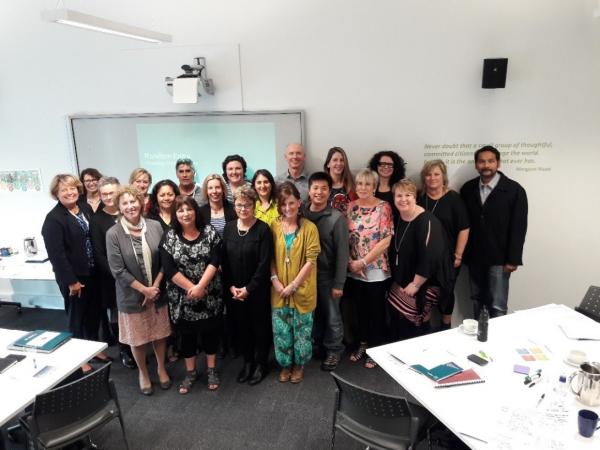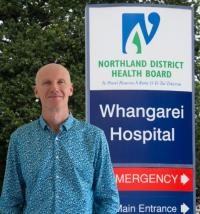Local QI projects underway in mental health & addiction sector

Participants of the Commission QI Facilitator Course at the October workshop
It’s just a few months since the new quality improvement (QI) facilitator training course started, and already participants from DHBs and NGOs across the country have begun to drive local projects to improve mental health and addiction (MHA) services.
Over the course of eight months, 24 students will be navigating their way through spaghetti diagrams, hot-spot mapping, affinity diagrams and other QI tools and learning, to support them to deliver positive changes within their workplace or service.
Each QI project has been carefully selected by participants to respond to a distinct need within their organisation’s MHA service area. While unique to each workplace, the projects all fall within the overarching MHA QI programme priority areas, which include:
- learning from serious adverse events and consumer experience
- maximising physical health
- improving medication management and prescribing
- improving service transitions
- minimising restrictive care.
Kickstarting QI projects

Daryl Quah, Equip Mental Health Services
With two learning workshops already under their belt, some students have kick- started their QI projects and are already gaining traction locally.
Daryl Quah, registered social worker with Equip Mental Health Services, aims to reduce wait times for new client referrals.
“Reducing wait times for new referrals is something that we take seriously but have not had the tools to make improvements to…Our biggest challenge is the lack of infrastructure or resource in data collection, but already we are starting to work around that."
“This has given us the chance to look at how to use the available data to improve our processes. It will help us to get a better sense of how we can work even more efficiently. How we can produce more with the existing resources, as opposed to just asking for more resources.” Read more about Daryl’s QI project.

Chantelle Waters, Health Informatics Officer, Canterbury DHB
Chantelle Waters is driving a QI project to take a closer look at moderate adverse events at Canterbury DHB, specifically those classified as severity assessment code (SAC) level 3s.
“Historically, most SAC 3s would get signed off by a clinical manager, and checked by a quality co-ordinator. They would not be presented routinely to our serious event review team, unless there was something of particular concern. So, there are a large number of SAC 3 rated events recorded in our system that have not had any significant analysis. I’m keen to go through that data and see if we can find ways to extract learnings out of those events.”
Working with driver diagrams has helped identify several potential change ideas for the project she says. “One or two of the more promising change ideas are to do with collating like-events together. So, say there are a number of SAC 3s which involved the police being called, it’s about going through those and looking for similarities, and starting to learn from those.” Read more about Chantelle’s QI project.
Other projects underway cover a wide range of MHA service areas, from an initiative to reduce wait times for MHA patients in ED, to improving effective discharge planning, medication charting, prescribing and compliance for metabolic monitoring of clozapine.
Delivering effective outcomes
While the projects are all unique, the QI methods and tools taught are designed to deliver effective outcomes for all, as Suzanne Proudfoot, course tutor explains: “The course is designed to support all participants through the complete project life-cycle.”
A key step to effective planning is getting really clear on what the problem actually is she says: “You need to be able to define the problem in a way that clearly captures the issues you are trying to change, and that will help shape the actions.” In addition, the course focuses on the importance of implementing effective change management strategies alongside any project: “You need to build the will before you begin to take any action”
While the course is driving individual projects, it is also designed to promote ongoing sustainable, localised QI capability.
Janice Bowers, Clinical Nurse Manager from Whanganui DHB says she found the collaborative learning environment effective: “We are all learning off one another. For example, someone who understands Excel can help you, while you help them in the area you are strong at.”
The course is running until March 2018, delivered by the Health Quality & Safety Commission, Ko Awatea and Counties Manukau Health in collaboration with MHA workforce agency Te Pou o te Whakaaro Nui. There are plans to repeat the course for
new students from July 2018.
Daryl Quah, Registered Social Worker, Equip Mental Health Services, Auckland

Daryl Quah, Equip Mental Health Services
How did you choose your project focus?
“Reducing wait times for new referrals is something that we take seriously but we have not had the tools to make improvements to. Traditionally we’ve done well in meeting the outcome measures required by the Ministry of Health, and we can improve on that by reducing wait times.
The feedback from consumer and staff is that people should not have to wait too long to receive support. When we heard of this QIF training course, we decided that the opportunity is here to take and start looking at how to reduce wait times. “
What is involved?
It’s about getting people to come together to raise awareness of how we are performing. We take a critical look at our current processes and investigate the factors that are impacting our wait times. More importantly we work as a team to look at how we can make immediate changes that will bring positive changes for all stakeholders.
What is your goal?
Our goal is for 80 percent of referrals to be seen within three weeks. We are hoping the other 20 percent will be seen within three to eight weeks and no one will need to wait for more than eight weeks for their initial assessment. Our future improvement project will look at where we can make continual improvement to ensure we can see all referrals within three weeks.
Progress so far?
It’s been going great. We are the smallest organisation involved in this course, and we’ve found that it’s not hard to get buy in. There’s not a lot of bureaucracy involved, and there’s a lot of support from senior management, at CEO level and down to staff, as well and service users too.
Challenges?
Our biggest challenge is the lack of infrastructure or resource in data collection, but we are already starting to work around that. We are looking at how we can collate all the process measures, for example, how is the waitlist impacted by how many hours are available in any given time, or looking at how many initial interviewers we should have to get the optimal level to reach our aim. Even looking at staff annual leave, sick leave, etcetera. This opportunity has given us the chance to look at how to use the available data to improve our processes.
What did you discover when you started your project?
From the baseline data we found our referrals rate was increasing by roughly 40 percent a year – but the number of full time staff available hasn’t changed. This means we are seeing more and more people within our existing resources. This project will help us to get a better sense of how we can work even more efficiently. How we can produce more with the existing resources, as opposed to just asking for more resources.
What value have you got from participating in the course to date?
It’s a lot (of value). To start off with we didn’t have the science or tools for a quality improvement project. What the course has provided is books, lectures and software that gives us the science of QI, such as how to determine what changes actually bring positive difference.
As well as tools, the course has given us support for eight months as well as securing the mandate to do it (the project) and get all the sponsors together. This course also provides networking opportunities, as I had the chance to meet a lot of other people from all over New Zealand who share the same passion.
Looking ahead
We’ve already talked about how we can continue this on and about possibly forming an ongoing quality improvement team. We have already decided our area of focus until December next year, so it won’t end in March (when the course finishes).
Chantelle Waters, Health Informatics Officer, Canterbury DHB

Chantelle Waters, Health Informatics Officer, Canterbury DHB
Chantelle Waters talked with us about how the MHA QI course has supported Specialist Mental Health Services at Canterbury DHB to take a closer look at moderate adverse events to drive improvements in the quality and safety of services.
What is project focus?
“We are looking at learning from moderate adverse events.
Any incident that occurs at the DHB, is given a SAC (Severity Assessment Code) number. SAC 1 or SAC 2s are serious events; death or serious injury, whereas SAC 3s are moderate events.
A diverse range of events can be recorded in SAC3s, such as accidents, damage to property, assaults, self-harm, and breakdowns in communication. There are significantly more SAC 3s than SAC1s or 2s, and due to the volume, it is harder to extract the organisational learnings due to the amount of processing involved.
Historically, most SAC 3s would get signed off by a clinical manager, and checked by a quality co-ordinator. They wouldn’t be routinely presented to our serious event review team (SERT), unless there was something of particular concern. So, there are a large number of SAC 3 rated events recorded in our system that have not had any significant analysis. I’m keen to go through that data and see if we can find ways to learn from those events.
How are you doing that?
I’ve been through the QI process that the tutor has taken us through, such as setting an aim and creating a driver diagram. I’ve had great support from my sponsor and I’ve been working with a number of people from SERT to understand the process, do some process mapping, and identify some possible change ideas.
Where is the project at?
My next step is to sit down with my sponsor and pick off one or two change ideas and run them through a PDSA cycle to see what the impact might be.
Some of the more promising ideas are to do with collating like-events together. So, say there are a number of SAC 3s which involved the police being called, it’s about actually going through those and looking for similarities, and starting to learn from those.
What is the intended outcome of the project?
It’s really about improving the safety of patients and quality of our service.
Have you got value from participating in the course?
Definitely. Doing a project alongside the training has really brought it to life and helped shape what we are talking about.”
Joe Crowley, Project Lead Service Development Team, Northland DHB

Joe Crowley, Northland DHB
Joe is one of the mental health and addiction (MHA) quality improvement (QI) facilitator training course participants. He talked with us about how the course is supporting his DHB to look more closely at wait times for patients with MHA issues.
What is the aim of your project?
To reduce the time of stay for patients with mental health and addiction issues in the emergency department (ED).
What was the reason for that?
EDs across the country are under enormous and ever-growing pressure. This programme is an opportunity for our MHA service to work with ED to identify and improve areas of shared concern using a QI framework. Ultimately, it’s about working together to improve the experience for MHA clients when presenting at ED.
What stage are you at with the project?
We are still in quite an early phase; getting the team on-board, identifying an issue, and demonstrating that any identified areas for improvement can be backed up with data.
Our hope for the project is to make the patient journey through ED and into the MHA service more seamless. In addition, the project is an opportunity to build and/or strengthen relationships between the services.
How have you found the training?
I’ve found it great. It’s worked really well with what I’m interested in and certainly around the skills I want to develop. Programme participants have been offered support from the team here and I’m intending to take advantage of this now I’m aware of what’s available.
How relevant is it to your work?
It’s extremely relevant; all projects I am involved in are ultimately quality improvement in nature, so this is very consistent with my role at Northland DHB. Plus, it’s great to learn a model that you can apply to other areas.
